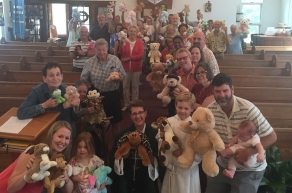
Last Fall, five faith communities from across the country embarked on their Pivot journey, an experience that now leaves them full of excitement, energy, and a sense of abundance for what’s ahead.
The Pivot program is a year-long, cohort-based online learning experience that allows smaller, under-resourced communities of faith to discern what God is calling them to be in their particular place and time while building relationships with other congregations from across the country. It also provides space for small church leaders to “pivot” their mindsets away from scarcity and failure, into identifying the key assets their congregation offers and the opportunities to engage and support their wider communities.
Continue reading...

The other day, my family and I went downtown. There’s only one incorporated town, really village center in the community in which we live. We missed the Taste of St. Mary’s by one hour – all the vendors were packing their tents – so we walked down the block, off the town square to the local pizza place for a late lunch. It’s great pizza; plus it’s fun to run into all sorts of neighbors. Following lunch, which turned out to be dinner, we walked another block over to the new ice cream place that opened last year – a storefront on an old warehouse building; the rest of the building itself now turned into a collection of real-time Etsy shops with an always-full beer garden in the back.
Years ago, none of those options were there. The buildings were there. The pizza place was a run-down seafood joint, and I have no idea what was in that warehouse. Back then, there was a diner, a coffee shop and a French restaurant and that was about it, save for a few funeral homes and florist shops. Now, the town is filled with yoga studios, art galleries, yarn shops, wonderful restaurants, a health food store, cooking studio, and so many more pop-up-shops-turned-creative-businesses.
Continue reading...

Matthew 18:19-20 Again, truly I tell you, if two of you agree on earth about anything you ask, it will be done for you by my Father in heaven. For where two or three are gathered in my name, I am there among them.
We emphasize numbers in the world of churches. We gather and report on numerical data - How many members, average Sunday attendance, number of pledges made, total “pledge and plate” collections. Was that more or less than last year?
Inevitably, this leads to the way we evaluate congregations. Steady or rising numbers indicate a stable or growing church. Shrinking numbers mean, uh-oh, that church is struggling, or worse.
“If this trend continues, well, someone’s going to have to make a decision to keep that church or close it. Afterall, how can a church with just two or three households survive?” we mutter.
Continue reading...

At long last, the two congregations I serve as rector are now one church – one church, we say, in two locations. Church of the Ascension in Lexington Park, MD and St. George’s Church in Valley Lee, MD are now two churches, two campuses of Resurrection Parish: the Episcopal Diocese of Washington’s newest parish, indeed the newest parish in our entire Episcopal Church! It’s been a long time coming, not to mention an incredible process; I’ve blogged extensively about our discernment around this initiative on ECF Vital Practices.
To be very technical, we merged two parishes into one parish. That may not seem super groundbreaking unto itself, but let me provide some context. St. George’s in Valley Lee is Maryland’s oldest continuous Anglican / Episcopal worshipping community – dating back to 1638 – and it became the parish church of William & Mary Parish when, in 1692, the colony was subdivided into 30 Church of England parishes (so much for Maryland’s heritage of religious toleration; we, too, got an established church not long after our founding). Church of the Ascension, meanwhile, was planted in a brand-new, post-WWII suburb as a mission chapel in the 1950s – along with so many other Episcopal church buildings and institutions in American cultural life – and it became its own full-fledged parish (Patuxent Parish) in 1968. Thanks, Baby Boom!
Continue reading...

A few years ago, I wondered aloud about whether, or when, The Episcopal Church would catch up to a growing phenomenon in Christian churches – multisite church planting and multisite church development. It was something I was reading about, especially because I was at the time serving one Episcopal congregation as rector while making plans to take on a second call with our neighbor church. That call developed and, as I’ve also written about, St. George’s, Valley Lee and Ascension, Lexington Park – two courageous congregations in the Diocese of Washington – have moved from conversations with one another to ‘yoking’ (an informal term for sharing everything, just not becoming one church) to merging.
I wondered a few years’ ago whether The Episcopal Church could borrow some multisite thinking. “We tend to see ourselves as one church,” I wrote, “at least theologically and spiritually as set in the landscape of other denominations. …Can this category apply to Episcopal congregations and communities in our church? And, if so, how? If not, why not?”
Continue reading...

From its beginnings, Christians have used metaphor to describe and teach about the Church. Most enduring is Paul’s metaphor of the Church as the Body of Christ, with each Christian a member of that Body. An eye, an ear, a foot, all important and contributing to the life of the whole. Cyprian and Augustine in the early church, and Luther and Calvin in the Reformation, notably referred to the Church as a Mother (to go with God the Father) and as the Bride of Christ. In the 20th century, Robert Farrah Capon wrote of the church as a hat on the head of a mystical body, allowing the mystical body to be located.
Metaphors usually don’t hold up under intense scrutiny. But they can certainly help us to see, to describe, to understand. Given that, and also the many examples of metaphors in the life of the faithful, I propose that to engage in metaphor is a vital practice of the Christian life. Doing so can teach and inspire in circumstances where literal descriptions fail or fall flat.
It is in this vein that I offer the metaphor of the Church as corgi. I refer to the little dog with short legs and cheerful spirit, popular on the internet, in photos, and household decor.
Continue reading...

When I was in my late 30s, I believed I had two vocations: I was a priest, and also a wife and mother. Both of these identities engaged my heart, soul, body and mind. Each fed and nourished the other. Both gave me my greatest cause for thanksgiving and my greatest fulfillment and sense of purpose. Both also prompted my most earnest prayers for guidance and forgiveness. They sometimes, even often, came into conflict, particularly in matters of calendar and clock. I keenly felt that each vocation had been blessed by God, and I believed that by engaging in them I was being faithful in my response to God’s call.
In those years, some 25 year ago now, I self-identified as a “bi-vocational priest.” One vocation came with a cash salary, the other did not.
Continue reading...

“How do you do Sunday mornings?” That’s perhaps the most common question I get when someone realizes that I serve as one rector of two congregations. The question makes perfect sense, actually, and figuring out the Sunday morning worship schedule was among the most important things we did before launching our new, shared venture between Ascension and St. George’s – the two communities I serve.
In order to develop the fullness of Sunday morning worship, as well as make sure that neither church ‘lost’ a service, we wanted to develop two Sunday morning services at both churches. Both Ascension and St. George’s, each, have worship at 7:30am – one at St. George’s, one at Ascension.
Continue reading...

“How do you do Sunday mornings?” That’s perhaps the most common question I get when someone realizes that I serve as one rector of two congregations. The question makes perfect sense, actually, and figuring out the Sunday morning worship schedule was among the most important things we did before launching our new, shared venture between Ascension and St. George’s – the two communities I serve.
I need to state, up front, that we put out a survey. We mentioned it online, but we very intentionally surveyed the actual Sunday morning worshippers. We stuck in the bulletins a hard-copy half-sheet insert for four Sundays. We ran it well before we had to make the actual decision. We listened carefully to the feedback.
Continue reading...

As far as blogging goes, I’ve been quiet. I haven’t submitted a post to ECF Vital Practices since March of this year, which (not ironically) was around the time I accepted a new call as rector of a new congregation – Church of the Ascension in Lexington Park, Maryland. While that, in itself, would be good reason to be quiet(er) and focus more intentionally on the new community to which I’ve been called, I also didn’t leave my other job – rector of St. George’s, Valley Lee.
At a clergy conference a friend noticed my name tag gained an extra congregation. “Is this like a game of Monopoly?” he asked, wondering how many other ‘properties’ I could pick up along my way. That’s not at all my goal, but at the time I am curious how far we can push things in our church’s fairly outmoded business model. I’m not at all convinced we, the Episcopal Church, have arrived at a truly gospel-centered, ministry-first understanding of how and why we operate institutionally in the ways we do. Nor am I convinced that we really want to engage a prolonged and serious conversation about some of these fundamental ‘business’ assumptions.
Continue reading...

In 2015, Vital Posts recorded the planting of a new Episcopal congregation in Brownsburg, Indiana, just outside Indianapolis (Parachute Drop). Rev. Gray Lesesne, D.Min., Church Planter/Pastor, “parachuted” into this suburban area and worked the coffee shop crowd, discovering what he was called to find: diverse people seeking spirituality.
The small seed of a congregation that Fr. Gray planted has grown to nearly 130 people of Good Samaritan Episcopal Church. He says it is “a Spirit-filled operation that has gone beyond our wildest dreams.” The congregation stays united around a mission and identity rooted in service: Good Samaritan Episcopal Church is a growing community of open-minded Christians who seek to do what Jesus taught us: to include, love, and serve all people without exception.
Continue reading...

I’m back home preparing for my father’s funeral at the end of this week, and I’ve learned quite a bit being on the receiving end of pastoral care from a local church.
My dad, Dale Bentrup, is a lifelong Lutheran and a stalwart at the two churches he’s attended in my lifetime. His pastor, a dear friend of mine, has been a source of great comfort for my mom and family. And the outpouring of love and support from parishioners has taught me more about the role of the church than three years in seminary ever could.
Of all the word pictures and metaphors used to describe the church, one has always stuck with me: family. But as I’ve thought about it some this past week, I’ve decided that “family” isn’t a very good metaphor for the church.
Continue reading...

For many, their only worship experience or connection with other Episcopalians are in their home congregations. There are churches that are less than a mile apart and as individuals or congregations we have never visited or seen the inside of our neighboring churches.
The reasons given for being strangers to each other are many: we are too busy; they are “high” church and we are “low” church; we didn’t know there was another Episcopal church nearby; their members are of another ethnic or cultural background; it is hard to plan logistically given worship times, etc. How can we be welcoming and inviting to non-Episcopalians when we find it so difficult to exercise that habit among ourselves?
Continue reading...

Discussions of crowd size have blanketed the news this past month. Friday’s crowd was small, and Saturday’s crowd was bigger, so we judge the value of these two ideas based solely on audience participation.
The Episcopal Church knows a thing or two about decreasing crowd sizes. Too often, our “success” and significance as parishes (and as a national church) are measured by large numbers and our average Sunday attendance. The average ASA for parishes across the country dropped from 60 in 2014 to 58 in 2015. We can’t dispute those facts. But what if we could provide more meaningful information, by asking alternative questions?
Music has always been a struggle in our Spanish service at St. Mary’s. As we have slowly built membership in our largely low-income neighborhood, we are not anywhere close to generating the kind of offerings that would fully support the clergy time that goes into the service, much less paying a professional musician. We’ve tried different things over the years -- a priest with a guitar or piano, a capella singing, some paid musical help. In recent years, we’ve come upon what I would argue is the best musical situation yet: bartering for band music.
Continue reading...

The message heard loud and clear at our monthly UBE (Union of Black Episcopalians) meetings at different congregations throughout the Diocese of New Jersey was how difficult it was to fill all Sunday services with a clergy person. The reasons were varied; the congregation may have been in transition, or the full time clergy was on vacation, on sabbatical, or even ill.
One idea stood out from all of our discussions. A clergy person suggested we re-embrace layperson led Morning Prayer as a legitimate form of Sunday morning worship. Response was mixed. Anglicans from the Caribbean or Africa experienced Morning Prayer often, due to less frequent clergy availability due to the number of congregations to be served. Older members had positively experienced Morning Prayer as common practice in times past. For others it was a harder pill to swallow, as they believed if there was no Communion then we didn’t really have a Service. There was also feedback that Morning Prayer was unfulfilling and it some cases even boring.
Continue reading...
Back to school time! Pencils, pencil boxes, notebooks, markers, glue sticks, tissues, hand sanitizer... Lists of required school supplies are long and diverse for each grade, each school. Many churches engage their members to “shop the list” and bring items to be given to families in need, often supplying backpacks too – sometimes several hundred at a time.
Today, we highlight the extraordinary backpack ministry of Trinity Episcopal Church in Logansport, Indiana (Diocese of Northern Indiana). Trinity’s average Sunday attendance is 65. On August 6, many of those folks distributed more than 750 backpacks and all the supplies students needed.
In 2006, when Trinity first realized the community need, the church gave away 40 filled backpacks. School Supply Giveaway project chairperson Deb Miller says the effort grew because of the “generosity of spirit” living in the people of Trinity.
Continue reading...
A colleague recently mentioned that she was starting a music project for Christmas. The commitment for participants would be six weeks of rehearsals. She said it seemed much easier to get people to commit to something that had a clear start and finish date, rather than asking for an open-ended commitment.
Her plan got me thinking about how many church commitments are either open-ended, or just really long. Join the choir, and how do you ever get out? Join the vestry and you’ve just given away three years.
Once you’re on the hook for a long commitment, the only way out is to quit. Most people don’t want to be quitters. That alone may be enough to keep some people from joining.
Don’t get me wrong. I love my lifers in the choir. There are some Sundays when I only get up to go to church because I know they will be there, and I will get to sing with them. But not all of us are cut out to be lifers. When the only choices we are offered are an open-ended commitment and no commitment at all, many will opt for no commitment. Over-committed has become a way of life in some demographics. And most people still take commitment seriously. They would rather say no than fail to live up to what they have promised to do. They worry that they may have already taken on too much.
How many of the ministries in your congregation operate on a concrete, manageable timeframe? Do you offer people regular ways in and dignified ways out?
Continue reading...
I am reminded again and again that ministry takes time. Relationships take time. Changes takes time. New life takes time. Even resurrection took three days, for heaven’s sake.
We are in a huge hurry in the church these days. In part, we are making up for lost time -- time when we should have been reaching out and were mostly reaching in. But just because we didn’t pay attention to everything that we might have doesn’t mean that new ministries and new efforts will grow overnight. Just because we are worried that we might die before we find ways to grow again does not mean that we can rush the growing process beyond its natural rhythm.
I am blessed to be part of a collaborative ministry that includes a parish I served ten years ago. That parish was struggling then, and it still has its struggles. But it has much of the vibrancy and freedom and depth of relationship that I dreamed and hoped and prayed for it ten years ago, very little of which I saw in the time I was actually there. The people who have hung in there with the ministry see the beauty of the church’s scrappiness and love one another more deeply than they did when I was there. They are more motivated to bridge gaps of culture and language because trust has grown, trust that they are all working with love to build one church.
Continue reading...














